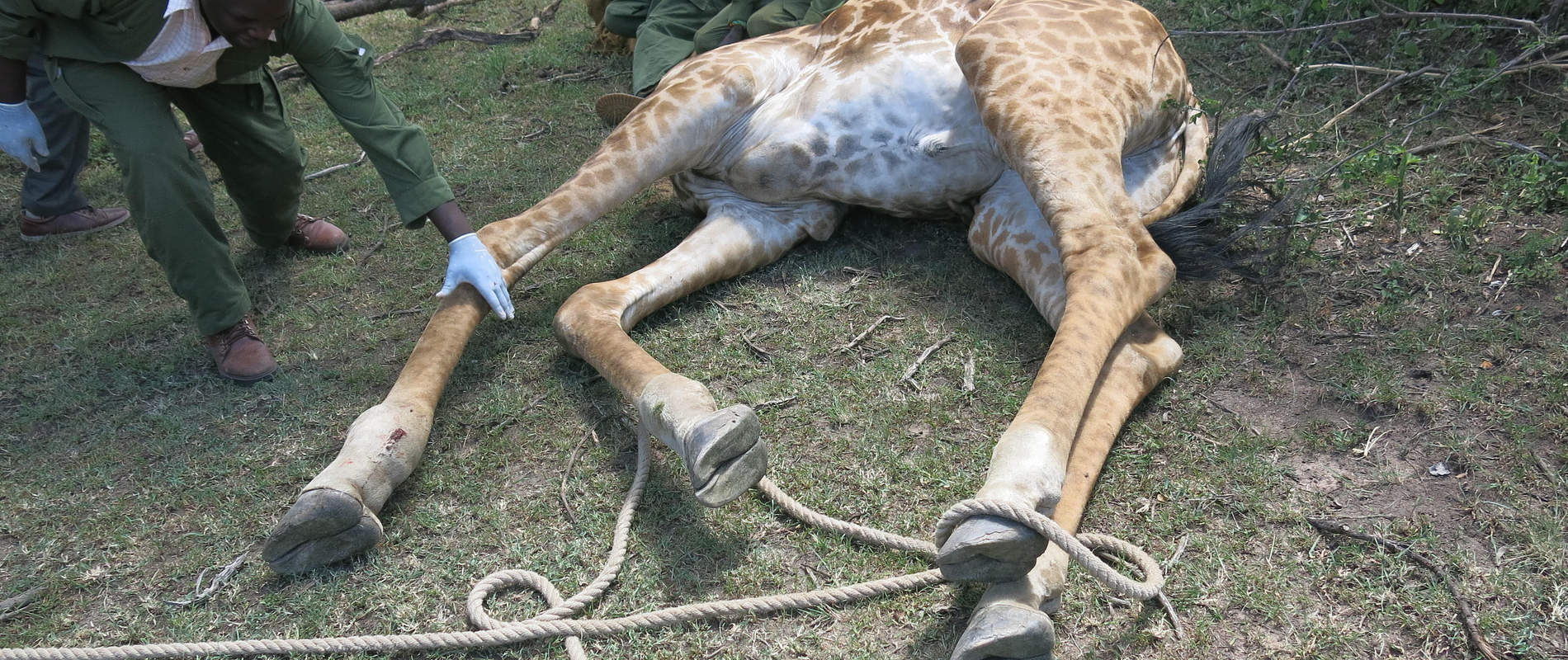MONTHLY VETERINARY REPORT FOR MASAI MARA -JAN 2015
MONTHLY VETERINARY REPORT FOR MASAI MARA -JAN 2015.
Reported by Dr.Campaign K. Limo
Introduction.
The month was characterized by a continuing drop in tourism activities. However pasture and forage is flourishing well and most grazers and browsers are doing well. Cases requiring veterinary intervention were low with many herds of elephants seen trooping back to the reserve. Spearing featured prominently across species attended to during the period.
Following are veterinary interventions carried out during the period under review.
CASE#1 TREATMENT OF A SPEARED ELEPHANT
Date: 18th January 2015
Species: African elephant (Loxodonta africana africana)
Sex: Male
Age: Young adult (about 18yrs)
Location: Mara North Conservancy
History
This young elephant was spotted with a limp on his right hind limb by Mara North Conservancy rangers on patrol. He was still in good body condition. They called the veterinary unit on the ground for examination and treatment. This elephant was in a group of about thirty others comprising of several families who had conglomerated. He showed obvious limp on his right hindlimb with noticeable suppurating wound lateral to the tarsal joint. Body condition was good though.
Immobilisation, examination and treatment
He was chemically immobilized with 13mgs Etorphine Hydrochloride delivered through a 3ml Dan Inject dart. Darting was done from a vehicle. The young bull remained calm after being darted, but remained close to his herd and family group.
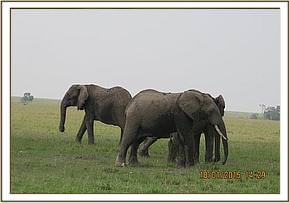

The drugs took full effect after eight minutes with the elephant going down on his left lateral. The protective family members were scared away by use of vehicles in order to give room for this elephant to be attended to. Due to the high ambient temperature, a lot of water was used to douse the elephant. His eyes were infused with Cloxacillin eye ointment to prevent corneal desiccation and his right ear was used as blindfold. His airways were kept open throughout the procedure by use of a small stick to keep the nostrils dilated.


Examination revealed a suppurating wound to the lateral surface of tarsal joint with a ventro-oblique course. The depth of the wound was about seven inches, but the joint integrity was not affected. The cause of the wound appeared to have been spearing. The wound was probed for any foreign body; none was found, and was then debrided using Hydrogen Peroxide. Dead debris was removed from the wound using a guaze swab and then wound was rinsed with water. The wound was disinfected by applying tincture of Iodine and was infused with Cloxacillin ointment. Oxytetracycline spray was used topically before the wound was packed with green clay. In addition 15000mgs of Amoxicillin antibiotic and 100mg Dexamethasone Sodium anti- inflammatory was given intramuscularly.
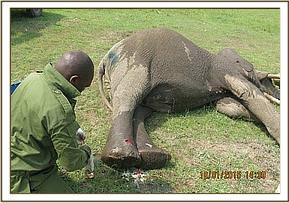

Reversal
Reversal was achieved by administration of 36mgs Diprenorphine Hydrochloride through superficial ear vein. He woke up after three minutes and joined the rest of the herd.
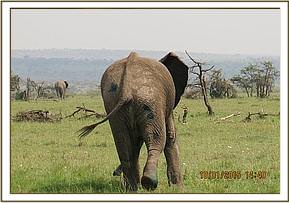

Prognosis
Good.
CASE#2 TREATMENT OF ELEPHANT WITH SNARE WOUND
Date: 20th January 2015
Species: African elephant (Loxodonta africana africana)
Sex: Male
Age: Young adult (about 18 years)
Location: Mara Triangle
History
This young elephant was spotted among hundreds of elephants with a limp on his left hind limb by Mara Triangle Conservancy rangers and the case was reported to the Vet Unit. The young bull appeared to be protecting the limb while walking. He was in a group of about a hundred elephants scattered across the plains of the Mara Conservancy and was sticking close to his mother, who had a younger calf and who was very protective of him.
Immobilization, examination and treatment
Immobilization was done by use of 13mgs Etorphine Hydrochloride delivered remotely through a 3ml Dan Inject dart. Darting was done from vehicle. It took eight minutes for the drugs to take full effect with this elephant assuming sternal recumbence. Once he was down, the mother would not initially let us approach him, but with help of more than two vehicles, she was eventually convinced to give the Vet Unit access to her calf. After making sure the elephant was stable, quick examination of the affected limb revealed an old snare wound at the heel. The snare had since fallen off leaving a raw wound, which appeared relatively clean. A sterile gauze soaked in dilute Hydrogen Peroxide was used to swab the wound to remove necrotic debris. Clean water was then used to rinse the wound before tincture of Iodine being applied as disinfectant. Oxytetracycline wound spray was then used topically before a coat of green clay being applied to promote healing.
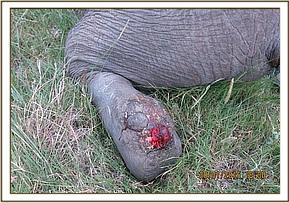

Additionally this elephant was given 15000mgs Amoxicillin antibiotic and 4500mgs Flunixin Meglumine anti-inflammatory, which were all administered intramuscularly.
Reversal
Reversal was achieved by use of 36mgs Diprenorphine given intravenously through superficial ear vein. He woke up after three minutes and joined members of his family who had remained close by.
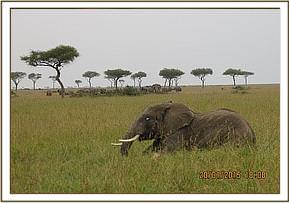

Prognosis
Good.
CASE#3 TREAMENT OF SPEARED ELEPHANT
Date: 21st January 2015
Species: African elephant (Loxodonta africana africana)
Sex: Male
Age: Adult (about 40 years)
Location: Masai Mara National Reserve.
History
This lone bull was spotted on the morning of 21st January on the roadside by the Narok County Security Team during their morning patrols. The elephant was said to be lethargic and discharge was seen coming from the left side of his thoracic area. The Vet Unit was called to examine and help. The elephant had moved a short distance from where he was seen last. He was heading to a small thicket and appeared nervous of sight of people. From a distance, there appeared to be a bloody tinged discharge coming from on the left side of his withers. His body condition was still good though he appeared to be in pain.
Immobilization, examination and treatment
Immobilization was achieved chemically by use of 17mgs Etorphine Hydrochloride delivered remotely through a 3ml Dan Inject dart using a vehicle. Upon darting, this elephant ran for a few minutes towards a small bush but was overwhelmed by the drugs in seven minutes. He went down on his right lateral affording us a good chance to examine the wounds.
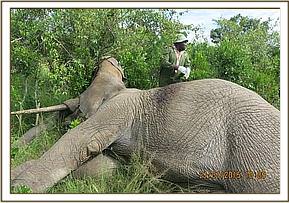

Upon examination, it was revealed that he had two wounds that were clearly caused by spearing. The first and bigger of the wounds were to his left upper thoracic region off the withers. This wound was about eight inches deep and four inches wide with maggots beginning to infest. The second wound was to his nape and about five inches deep. Both wounds appeared to have been inflicted at the same time, probably three days before intervention. The wounds were probed for any foreign body remnants; none was found, before all maggots were manually removed and the wounds were debrided using Hydrogen Peroxide and gauze swabs. After rinsing with clean water, the wounds were disinfected with tincture of Iodine and Oxytetracycline spray was applied. Finally the wounds were packed with green clay to promote quick healing. Finally, 15000mgs amoxicillin antibiotic and 100mgs Dexamethasone Sodium anti-inflammatory were administered intramuscularly.


Reversal
Reversal was achieved by intravenous administration of 48mgs Diprenorphine Hydrochloride through superficial ear vein. An additional intramuscular administration of 150mgs Naltrexone was also given. The elephant woke up within two minutes and headed straight into a bush.
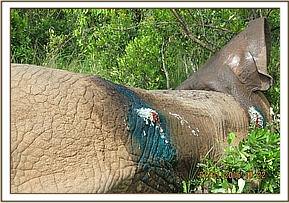

Prognosis
Good.
CASE#4 TREATMENT OF SPEARED LION
Date: 23rd January 2015
Species: Lion (Panthera leo)
Sex: Male
Age: 2 years
Location: Mara North Conservancy
History
This young male was seen with an obvious injury on his right upper thoracic region by Mara North Conservancy rangers. He was in a pride of about nine members that was alleged to have feasted on a cow a few days before. The rangers called the Vet Unit to seek assistance to treat this lion. This lion was seen close to the other members of his pride but spent most of the time lying down. He appeared weak with a visible wound to his upper right thoracic region. He appeared to be having difficulty breathing.
Immobilization, examination and treatment
This lion was immobilized with a combination of 3.6mgs Medetomidine and 200mgs Ketamine delivered using a 3ml Dan Inject dart fired from a vehicle. It took eight minutes for the lion to be fully anaesthetized, at which point a blind fold was applied and the lion taken to a shade. Cloxacillin ointment was applied to both eyes.
Examination revealed a deep sharp edged penetrating wound measuring seven inches wide and deep enough to access the pleural cavity between two ribs. The wound was most likely caused by spearing. The lion was breathing with difficulty and some air was escaping from the pleural cavity through the wound opening causing rapid, shallow breathing. A big blood clot was found on the edge of the wound margin and more blood clots were suspected to be within the pleural cavity. This, combined with the leakage of air through the wound could have led to limited lung movement and the rapid shallow breathing. Treatment was done quickly in order to stabilize the animal and prevent further deterioration.
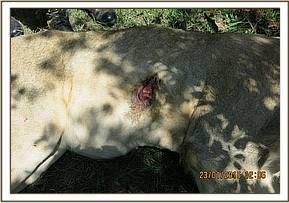

Most of the blood clots were removed and the wound was immediately closed using a No. 8 metric chromic catgut suture and an additional subcutaneous suture pattern was applied to prevent any further air leakage. Finally, the skin was closed using a No. 6 metric Nylon. Though the air leakage was stopped, damage caused by clots in the cavity and the prolonged exposure of the pleural cavity to a contaminated environment proved a challenge. Suture lines were infused with Cloxacillin ointment and tincture of Iodine before green clay was applied. In addition 3000mgs Amoxicillin antibiotics and 20mgs Dexamethasone Sodium anti-inflammatory was given intramuscularly.
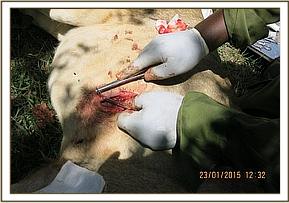



Reversal
Reversal was achieved by intramuscular administration of 15mgs Atepamezole one and half hours after immobilization. The lion woke up after eight minutes to join other members of the pride.


Prognosis
Guarded.
Puncture into the pleural cavity and the pneumothorax is considered a serious injury which can be fatal. Lungs can easily collapse leading to dyspnea and progression to complete apnea. In such situations, respiration is highly supported with the patient being prevented from any slight exertion while treatment is being executed. The team on the ground was informed of possible scenarios and instructed to let the lion rest with minimum disturbance.
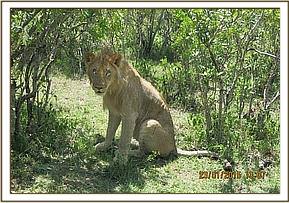

CASE#5 WILDEBEAST RELOCATION
Date: 23rd January 2015
Species: Wildebeest (Connochaetes taurinus)
Sex: Male
Age: Adult
Location: Olkinyei (PCEA Acacia Missionaries’ Compound)
History
This wildebeest was rescued a few years ago after his mother was allegedly killed by locals. He grew up within the missionaries’ compound enjoying the security and company of the residents. Though other wildebeests are seen nearby and he has been known to join them on occasion, he always returns to the compound due to his habituation. At three years old, this wildebeest had started to become aggressive and dangerous. As a result, KWS management, in consultation with the county administration, decided it should be relocated to the wild, far from the compound to any conservancy with a population of wildebeests.
Capture and release
The wildebeest was immobilized by use of a combination of 5mgs Etorphine and 50mgs Azaperone in a 3ml Dan Inject dart, which was done from foot. The drugs took effect after five minutes after which the wildebeest was blindfolded, put in the back of a pickup truck and made to lie on his sternum. He was transported some seventy kilometers away and released successfully into Olkinyei Conservancy.
Reversal
Reversal was achieved by administrating 18mgs Diprenorphine Hydrochloride through the jugular vein and additional intramuscular administration of 75mgs Naltrexone. He woke up after three minutes and joined other wildebeests nearby.
CASE#6 TREATMENT OF A GIRAFFE WITH AN ARROW WOUND
Date: 24th January 2015
Species: Masai Giraffe (Giraffa camelopardalis tippelskirchi)
Sex: Male
Age: Adult
Location: Siana Conservancy, Maasai Mara
History
This young adult was seen limping and in company of a resident herd in Siana Conservancy. The conservancy management called the Vet Unit for assistance. This giraffe appeared to limp while walking though he kept pace with the rest of the herd. His left carpus appeared slightly swollen.
Immobilization, examination and treatment
This giraffe was immobilized using a combination of 11mgs Etorphine Hydrochloride and 50mgs Azaperone in a 3ml dart. Darting was done from a vehicle. The drugs took effect after eight minutes and the giraffe was pulled down and restrained with the help of ropes.
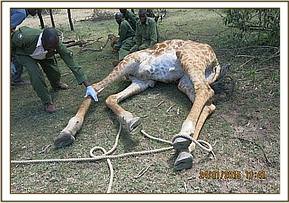

Examination revealed an arrow head lodged in the lateral surface of his left carpus. It was estimated that the arrow head had been in place for the about two days. The arrow head was gently pulled out and resulting wound was relatively fresh. The wound was cleaned with water, before being debrided using Hydrogen Peroxide and rinsing again with clean water .The wound was then wiped dry with a sterile gauze swab. The wound was disinfected using tincture of Iodine and Cloxacillin ointment was applied.
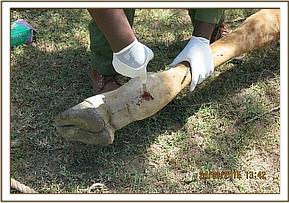

The wound and surrounding area was sprayed with Oxytetracycline before 4500mgs Amoxicillin antibiotic and 40mgs Dexamethasone Sodium anti-inflammatory were administered intramuscularly.
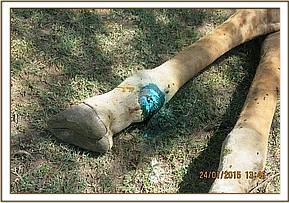

Reversal
Reversal was achieved by administration of 30mgs Diprenorphine intravenously through the jugular vein. The giraffe woke up in one minute and galloped off to rejoin the rest of the herd.
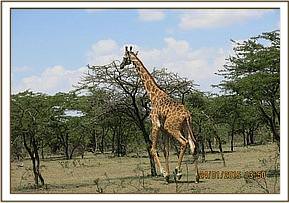

Prognosis
Good.
CASE#7 TREATMENT OF ELEPHANT CALF WITH SNARE WOUND
Date: 28th January 2015
Species: African elephant (Loxodonta africana africana)
Sex: Male
Age: 3 years
Location: Mara Triangle
History
This elephant calf had been sighted three weeks previously by the Mara Conservancy rangers, but he disappeared as soon as the Vet Unit arrived at the location and despite a frantic search for the next two days he remained lost. However, he resurfaced on the morning of the 28th January with his mother and the Mara Conservancy rangers immediately called for assistance and followed the pair until the Vet Unit arrived. The mother elephant and her injured calf were out in the open some distance away from other elephants. The calf was walking with some difficulty and was limping with his left forelimb. Closer observation showed a wound around his left carpus.
Immobilization examination and treatment
The calf was immobilized using 3.5mg Etorphine Hydrochloride delivered through a 3ml Dan Inject dart shot from a vehicle. The drugs took 8 minutes to take effect. His mother refused to abandon her calf and she stayed close until after he was overwhelmed by the anaesthetics at which point attempts were made to scare her away using vehicles. She resisted for a while, but eventually resigned herself and moved away to watch the action from a safe distance.
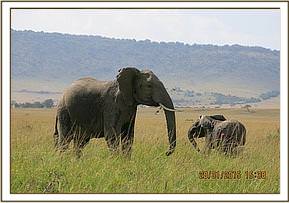

Examination revealed a septic wound round his left carpal joint that had been caused by a snare. The snare had since fallen off, but it had left behind a big wound and had caused partial damage to some ligaments. The wound was thoroughly probed for any snare remnants, but nothing was found. The wound was cleaned with Hydrogen Peroxide and copious amount of water. Gauze swabs were used to wipe it dry and necrotic tissues removed.


The wound was disinfected using tincture of Iodine before Oxytetracycline spray was applied. Green clay was packed into the wound to promote healing. Lastly the elephant calf received intramuscular injection of 3000mgs Amoxicillin antibiotic and 30mgs Dexamethasone Sodium anti-inflammatory.


Reversal
Reversal was achieved by administration of 12mgs Diprenorphine Hydrochloride intravenously through the superficial ear vein. The elephant calf woke up after three minutes and was herded towards his waiting mother. The mother and the baby were reunited.
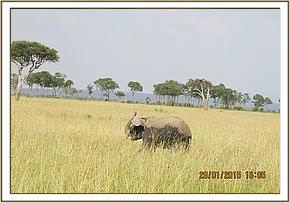

Prognosis
Good.
Conclusion
The Mara Mobile Veterinary Unit is grateful to all the stakeholders who in one way or another contributed towards the reporting and treatment of these cases. Thanks to the management of the Maasai Mara National Reserve and the surrounding Conservancies for their vigilance and prompt reporting. Many thanks also go to Minara Foundation through The David Sheldrick Wildlife Trust (DSWT) for their continuous support and facilitation to the unit. Thanks also to Kenya Wildlife Service (KWS) through the Head of Veterinary Services for their technical and material support. Their continued collaboration with DSWT has resulted in the rescue and treatment of many innocent and suffering animals.
